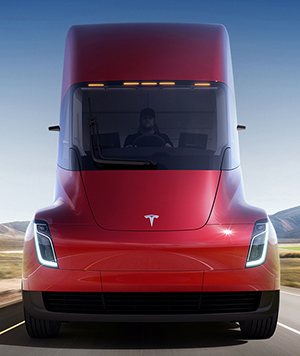Managing Editor, Features and Multimedia
On Tesla Trucks and ELDs
Tesla Inc.’s recent unveiling of its all-electric Class 8 tractor presented the industry with a fresh take on truck design and a different way of powering its vehicles. While most of the attention naturally went to the truck’s all-electric powertrain, the Tesla Semi also featured next-level automated driving technology, including active steering.

Seth Clevenger
Tesla co-founder and CEO Elon Musk said the vehicle will come standard with what he called “Enhanced Autopilot,” an iteration of the driver-assist technology available in Tesla passenger cars.
YOUR GUIDE TO THE MANDATE: Downloadable PDF.
In the Tesla Semi, that system will provide automatic lane keeping, automatic emergency braking and lane-departure warnings, he said at the truck’s Nov. 16 unveiling in Hawthorne, Calif.
If the driver has a medical emergency, the truck will automatically stay in its lane, gradually come to a halt and call for emergency services, Musk said.

Tesla's electric tractor, set to enter production in 2019, will come standard with automated-driving features.
However, the Tesla Semi isn’t scheduled to enter production until 2019, meaning it likely will reach the market around the time that the industry’s more established truck manufacturers and suppliers will begin introducing automated steering capabilities of their own.
Apart from Autopilot, Tesla’s truck incorporates a high-tech driver interface in the cab.
The truck discards the dash display altogether and presents all driver information on two large touch-screen displays, one on either side of the wheel.
Even the speedometer and air conditioning controls have been moved to these touch screens, which also display navigation software, video from blind-spot cameras and other information.
It will be interesting to see how drivers respond to this very different setup. Many of today’s drivers may need time to adapt to such a significant change, but millennials who grew up playing with tablets and smartphones likely will take to it immediately.
The countdown to the electronic logging device mandate is nearly over.
That federal regulation, which will require truck drivers to record hours of service on ELDs rather than paper logbooks, goes into effect Dec. 18, just a week after the publication date for this issue of iTECH.
ELDs will improve regulatory compliance and enhance safety across the trucking industry, but the move to electronic logs will necessitate better planning by all parties in the supply chain.
As the industry enters this new regulatory landscape, tighter enforcement of hours-of-service limits also could heighten awareness of problems with driver detention time, congested traffic and the truck parking shortage.
While some opponents of ELDs have pointed to those challenges as reasons to oppose the mandate, they are really concerns about hours of service. ELDs don’t change the hours-of-service limits, just the means by which they are enforced. And the proper response to hours-of-service challenges is not to skirt the rules by fudging paper logbooks.
At least for driver detention, the real solution will need to come from frank conversations between carriers and shippers about the value of drivers’ time — in terms of operating within the bounds of hours of service and improving driver job satisfaction.
Drivers’ time is their livelihood, and some shippers will need to better respect that time by not holding them up at their facilities.
At the same time, some fleet managers and dispatchers will need to do a better job of planning to avoid putting drivers in untenable situations under hours of service.
When the industry completes its transition to electronic logs, all players in the supply chain will need to come to grips with the reality that complying with hours of service is the law, not merely a suggestion.




